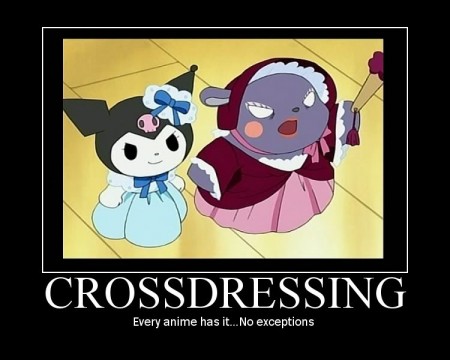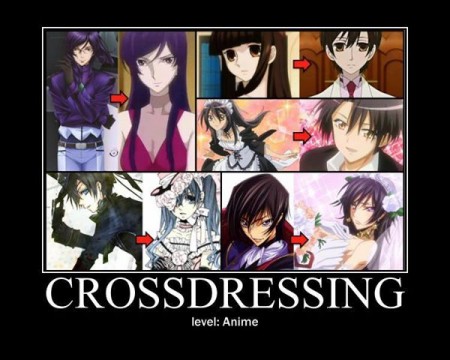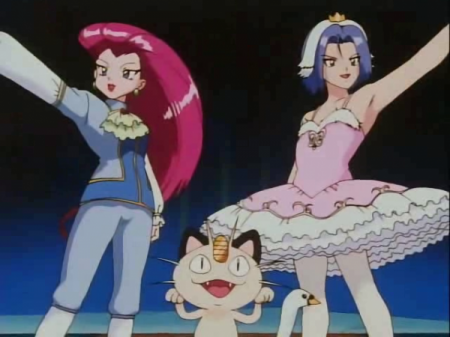Ask John: What are the Best Cross-Dressing Anime?

Question:
What anime have had the best use of crossdressing characters?
Answer:
The lack of contextual specificity inherent in the question allows for at least two different approaches to an answer because cross-dressing as a literary theme has at least two distinctly different functions in anime. Looking at the concept from the perspective of commentary on gender identity, the anime series that introduced the concept, Ribbon no Kishi and Rose of Versailles, must be considered. These two shows took a serious look at how conscious gender cultivation affects children’s psychology, introducing the idea that traditional gender opportunities and roles are more a matter of procedural bias than physiological mandate. Shoujo Kakumei Utena partially upended the traditions of Rose of Versailles by making the protagonist’s decision to cross-dress a personal desire rather than a prescribed position. Unlike earlier anime that depicted female characters dressing as men out of necessity or obligation, the Utena franchise depicted a girl who chose to dress in masculine clothing because she admired and consciously wanted to portray a male chivalric persona. Utena Tenjou is a fascinating character because she independently and intentionally desires a dual-gendered identity; she respects her femininity while simultaneously trying to cultivate aspects of a male persona. She expresses this effort through her choice of clothing. In terms of observing and deconstructing uncertainty over gender identity that manifests partially through cross-dressing, no other anime franchise has even attempted as serious and thorough of an analysis as Hourou Musuko.
Countless anime have utilized cross-dressing as a disposable gag. Examples include Patalliro, City Hunter, You’re Under Arrest, Pocket Monster, Lupin III, Working, Moyashimon, and Minami-ke, just to name a limited few. Numerous anime have revolved around cross-dressing, using the practice as a cliche or easily exploitable trope, such as Oira Sukeban, I My Me! Strawberry Eggs, Princess Princess, Mariaholic, Ouran Koukou Host Club, and Otome wa Boku ni Koishiteru. To say nothing of the quality of these shows, the cross-dressing prominent in these anime is present for lighthearted entertainment value. However, select other anime from this same category treat the practice with unusual verve or with an unusual approach.
The 1983 Stop!! Hibari-kun! television series is superficially most comparable to a later series like 2009’s Mariaholic in the respect that the cross-dressing boy is the series’ primary supporting character rather than the protagonist, but the major distinguishing highlight of Stop!! Hibari-kun! is the way it uses the trope of cross-dressing to illustrate the impacts of the practice on surrounding people. While the show is partially about cross-dressing high school boy Hibari Oozora, a greater emphasis is placed on how Hibari’s insistence on pretending to be a girl affects his father and best friend.
The 2010 Kuragehime television anime likewise relegates the cross-dressing boy to a primary supporting character role but uses his preference for beautiful, baroque feminine clothing to illustrate a larger point about defining the self not by gender or by societal and peer pressure but rather by individual expression. Kuranosuke Koibuchi, unlike Utena Tenjou, doesn’t have a sublimated compulsion to adopt a cross-gender identity role. Unlike Utena, who wants to transpose into a male role, Kuranosuke doesn’t want to adopt a feminine, matronly role; he only wants to become emotionally closer to his estranged mother
The current Genshiken Nidaime television series deserves some credit for attempting to examine a motivation for cross-dressing that’s neither based in gender-identity confusion nor situational comedy. Kenjiro Hato cross-dresses partially as a reaction to emotional trauma, and partially as a physical manifestation of his psychological justification for deeply sublimated homosexuality. Hato admits his attraction to yaoi themes and artwork but insists that he’s heterosexual despite occasionally envisioning himself in homosexual encounters. Hato doesn’t perceive himself as feminine at all. Rather, he cross-dresses in order to psychologically detach his interest in homosexuality from his “masculine” persona. The psychological and relationship drama that emerges from Hato-kun’s introduction into the Genshiken narrative does bring a degree of soap opera melodrama into a story that’s otherwise a satirical slice-of-life comedy. So the tonal shift resultant from Hato’s character may not be entirely welcome in the Genshiken story, but it is an interesting, unique perspective on cross-dressing within anime.
The 2006 television series Happiness! demands a small degree of notice for proliferating the modern concept of the “josou” or “otokonoko” trope that’s better known to English speakers as “trap.” While earlier anime like the 1991 Koko wa Greenwood OVA series introduced characters like Shun Kisaragi, effeminately attractive boys, the 2006 Happiness! TV series character Jun Watarase sent the concept of the cute-looking girl who’s actually a boy into otaku culture prominence, leading to subsequent anime and characters including Baka to Test to Shoukanjuu’s Hideyoshi and Shounen Maid Kuro-kun.
If I may be indulged, one additional example that I believe deserves special mention comes from the 1997 fifth Crayon Shin-chan motion picture, “Ankoku Tamatama Daitsuiseki” (“Pursuit of the Balls of Darkness”). The trio of “okama” that initially threaten then assist the Nohara family throughout the movie absolutely rival One Piece’s Emporio Ivankov as anime most fun transvestite characters ever.
Add a Comment
You must be logged in to post a comment.




What about the infamous AnoHana scene ? Mari Okada seems to love crossdressing characters.
Uhhh, yep, I don’t think I can even come up with a title that should’ve been included.